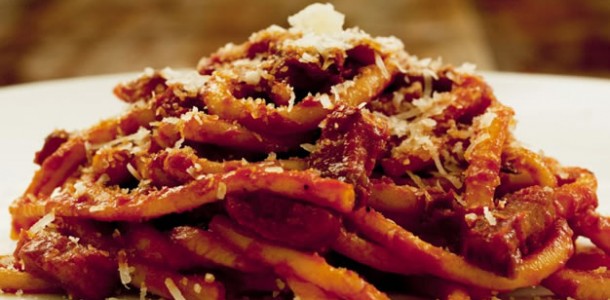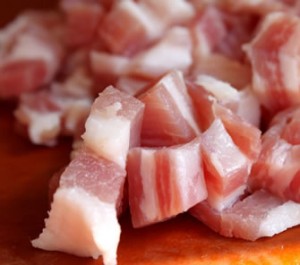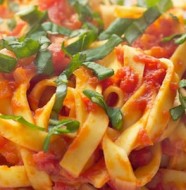- extra virgin olive oil
- 1 medium onion diced
- 8 ounces salt pork - rind (skin) removed and diced into 1/4 inch cubes
- 1/2 teaspoon red pepper flakes
- 2 tablespoons tomato paste
- 1 (28-ounce) can whole pealed tomatoes
- 2 ounces Pecorino Romano cheese, finely grated
- 1 pound bucatini pasta
Bucatini all’Amatriciana is considered Italy’s most celebrated pasta and for good reason. With relatively few ingredients it delivers a pasta that is the perfect balance of sweet, salty, and acidic. In fact, there are few dishes in the entire Italian canon that can deliver the same depth of flavor as Bucatini all’Amatriciana, and certainty none that can do so with the relative ease of this pasta.
But this perfection is not without controversy. Every Italian has an opinion on food that comes almost as a birthright. And, if there is one thing Italians love more than eating, it’s arguing about cooking. It is thought that this pasta originated in Amatrice, a small mountain town northeast of Rome. But ask the average Roman and you’ll find that most proudly claim it as their own and say its name has nothing to do with its origins. Even the type of pasta used is a controversial topic.
One thing that is beyond argument is that with your first mouthful of Bucatini all’Amatriciana you will find it difficult to believe that so few ingredients could possibly yield such an amazing depth of flavor. That flavor is due to the use of guanciale, salted pork jowls. In fact, it is so essential to the creation of this dish that without it, you would not even have anything that resembles this dish. But finding guanciale outside of Italy can be a challenge. Enter salt pork.
Recently salt pork has become available across the country in your local mega-mart. The difference between guanciale and salt pork is that the latter actually comes from the belly of the pig. Like guanciale, salt pork has a ratio of about 70% fat to 30% meat and delivers the intense pure-pork flavor needed to pull this dish off successfully.
Salt pork is typically sold in blocks running from about 8 ounces to about 1 pound. Most of the time, you’ll need to remove the rind (skin) prior to dicing it into 1/4 inch cubes. The easiest way to do this is to to put your salt pork in the freezer until it firms up. Then using a sharp knife, carefully cut along just under the rind to remove. Firming your salt pork in the freezer will also make it much easier to dice.
American bacon is not a substitute for salt pork. The smoky-sweet taste completely changes the character of the dish. The essential balance that has made this pasta so celebrated depends on the clean, meaty, porky flavor of guanciale or salt pork.
Let’s turn our attention to the pasta used. Living in Rome visited on me a clear bias when it comes to this dish and I call for the use of bucatini, a long pasta with a hole down the center. This tubular pasta has a rough surface and hollow center which easily holds on to and fills up with this amazing sauce. I’ve used linguini in a pinch, but it’s my opinion that using bucatini is essential to the character of the final dish.
Bucatini all’Amatriciana also depends on a good Pecorino Romano or simply Romano cheese. Pecorino Romano is a funky sheep’s-milk cheese with a great bite that is transformative in this dish. Finding good imported Italian Pecorino Romano is really easy in today’s mega-marts. Avoid pre-grated domestic cheese and source your cheese from either the cheese counter in any mega-mart or from a local cheese monger in the specialty cheese shops that have popped up all over the country in practically every big city.
You’ll be stirring the cheese into the hot sauce near the end of your preparation which can present a problem as the cheese tends to want to melt into clumps instead of melting evenly through the sauce. I was taught to add the cheese to about 3 to 4 tablespoons of fat rendered from from salt pork at the beginning of the recipe and mix the two into a paste before adding it to my sauce. It wasn’t until later in life that I learned the science behind this technique. The fat coating on the cheese keeps the proteins in the cheese from bonding together and allows it to melt consistently through the sauce.
Finally, we have to address the North-American habit of piling pasta on a plate and then dressing the top of it with sauce. This is one of those dishes that requires you to dress your pasta like an Italian for a couple of reasons. To begin with, you’ll be cooking your pasta to within about minute of it reaching a proper al dente stage where it is just cooked through and then transferring it to the large skillet or pot containing your sauce. Next you’ll be adding to the same skillet or pot about 3/4 of a cup of water in which you boiled the pasta before tossing it all together with tongs.
The first thing this does is properly dilute the sauce which would be too salty on its own. The second thing this does is to allow the pasta to finish cooking by soaking in the sauce and literally infusing the pasta with the unxious flavor that is Bucatini all’Amatriciana.
Directions:
- Place a large saute pan over medium heat and add enough extra virgin olive oil to completely cover the bottom. Add the diced onion and sauté for about 5 to 8 minutes or just until the edges of the onions begin to turn translucent.
- Add the diced salt pork and continue to sauté for 8 more minutes being careful not to let the onions take on any color. Remove 3 to 4 tablespoons of oil from the pan and reserve for later.
- Add the red pepper flakes and continue to sauté for 3 to 4 more minutes.
- Pour the canned tomatoes, including the liquid, into a large bowl and by hand, squeeze them until they are completely broken apart. Add the tomatoes and tomato paste to your saute pan, bring to a boil and reduce to a simmer for 35 to 40 minutes allowing the sauce to thicken. You are looking for a sauce thick enough that a spoon pushed across the bottom of the pan will briefly reveal the pan bottom before the sauce fills it back.
- Meanwhile, cook the bucatini pasta according to the package directions until about 1 minute before al dente. Drain the bucatini without rinsing and reserve 3/4 cup of the pasta water.
- Add 1/2 of the grated Pecorino Romano cheese to the reserved oil, mix into a paste and add to the sauce stirring it in until it is completely melted through.
- Add the 3/4 cup pasta water and bucatini to the sauce in the pan, toss through with tongs, allow to sit for 3 to 4 minutes and serve along with the remaining half of the grated Pecorino Romano cheese, allowing your guests to add as much as they like.










Gregory:
I had this years ago while on a trip to Rome and have tried to make it so often and with so many different recipes never able to recapture it successfully. My husband laughs each time we find it on a restaurant menu because I always order it and am always disappointed.
I found your site while looking for osso buco and when I saw this recipe and read about salt pork I ran out to the market immediately to get some. Let me tell you, it was everything I remembered and wanted it to be!
Love your writing style, love your take on food and love how you teach us enough to understand what we are cooking and not just following a connect the dot. I’ll be waiting for more to come.
Janie:
Thank you for the wonderful comments!
Gregory